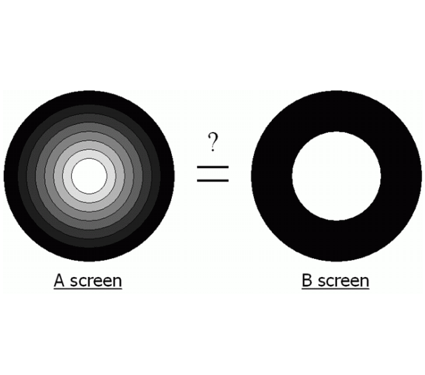26" LCD TVs: Are They Ready for Prime Time?
Brightness And Contrast
Unlike computer monitors, brightness is an important parameter in the choice of a TV set. Since a TV set is viewed from a distance, a (measured) brightness of 220 to 250 nits is appropriate, where for a computer monitor, that would be too bright. When we talk about brightness here, we're referring to the values we've measured ourselves, not the exaggerated, basically useless values claimed by the manufacturers. Some claim up to 800 nits of brightness, a level that would be like looking at a welding torch through a color slide.
Contrast is another story. A good contrast level is always preferable, but you have to be careful not to confuse contrast ratio and screen dynamics. Here's an example to make that a little more clear.
Here I am trying to display concentric circles in shades of gray, from the lightest to the darkest. Screen A shows the shades correctly, but screen B shows only two shades. They have the same contrast ratio - that is, the relation between the whitest point on the screen and the blackest - but not the same dynamics. Screen A shows more details and more nuances than screen B.
So as you can see, you need to be careful about manufacturers' claims regarding contrast ratio.
Latency
Latency is a crucial parameter for users of LCD monitors, because LCD panels are fundamentally slow. The latency measurement indicates the time it takes for a pixel to change from totally black to saturated white and back to totally black again. Unfortunately, that value is not very representative of reality, because pixels rarely make such extreme transitions. A pixel can change, for example, from dark gray to a lighter gray, and in that case the latency is much worse than what the manufacturers claim.
Here are some examples:
This curve shows the different latency values as a function of the gray level to be displayed. A change from black to white is shown on the curve as a point at 255 on the X-axis, a black-gray transition is 125 on the X-axis, an alternation between black and dark gray is 50, etc. The official ISO response time specified by the manufacturer is only for black/white transitions (0/255). While the value we measured is in agreement with the manufacturer on this point, it doesn't mean much as far as the panel's real-world responsiveness is concerned.
Get Tom's Hardware's best news and in-depth reviews, straight to your inbox.
For more details on the testing method we use, take a look at this article .
On the left is an MVA panel specified at 25 ms; this the panel used in the BenQ FP71W. On the left is a 25 ms TN+film panel, the one used in the ViewSonic VX715. But as you can see from the curves, the MVA panel shows an actual latency of more than 120 ms in the worst cases, whereas the TN+ film panel never goes higher than 35 ms.
We can conclude from this that:
- Two 25ms screens are not necessarily the same.
- A screen's specified latency alone is not enough to judge its actual responsiveness.
While computer applications are highly sensitive to latency, TV sets are a different matter. A TV doesn't have a refresh rate of 60Hz by default - depending on the format, the rate is most often 30 Hz, or 30 images per second interlaced. That would seem to mean that a latency of 33 ms (1/30 Hz) would be sufficient, but that's not so. It's theoretically sufficient for an interlaced signal, but not for applications on a PC, like video games for example. And with PC/TV convergence the coming thing, 33 ms is not really enough. It would also rule out progressive video formats like 720P. And even for ordinary TV use, a 33 ms latency would be visible when sudden movements occur on-screen.
So it should be clear that the stated latency value of an LCD panel is a characteristic that needs to be taken with a grain of salt before you drop $1,500+ on a TV. That was true for computer monitors, and it's just as true for LCD TVs as well.
Current page: Brightness And Contrast
Prev Page Separating The Wheat From The Chaff Next Page Viewing Angles
